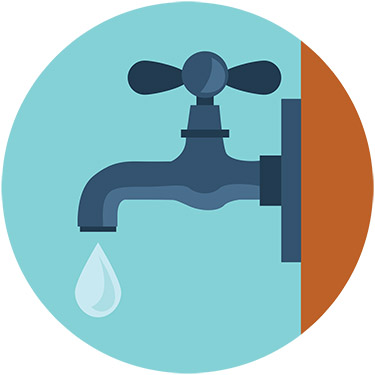Waterwise home
Leaks
Many household leaks are not easily detected and can lead to high water bills.
You should check your water meter regularly (monthly or 3-monthly) to monitor and understand how much water you use. This will also help locate leaks early, saving you both water and money. A water audit (PDF, 741KB) of your household can also tell you how much water you use and if you might have a leak.

If you do not regularly check your water meter, the first sign of a water leak might be a higher than normal water bill.
A large amount of water can be lost due to leaking pipes and dripping taps. One slowly dripping tap can waste more than a bucket of water a week, while a visibly leaking toilet can waste up to 18 buckets of water a day.
Make sure you turn all your taps off properly; check for leaks and repair taps and keep all water fittings and equipment in good condition.
How to check for water leaks
- Turn off all taps tightly and make sure no-one will be using any water on your property for the next hour.
- Find your water meter and write down the numbers shown.
- After 1 hour, check the water meter reading. If the numbers have changed, there may be a leak.
- If it appears there is a leak, the first item to check is the toilets. To check if you have a leaking toilet, turn off the water valve located behind each toilet. Put a little food colouring in the toilet cistern. If, without flushing, the colouring begins to appear in the bowl, the cistern rubbers need to be repaired. Note: After the test, flush your toilet twice to prevent the food colouring from staining the toilet bowl.
- While the toilet water valves are turned off, repeat steps 1 to 3. If the numbers have increased, there is a leak somewhere else on your property. Check for leaks from taps, showers, your hot water system, and look around outside for unusually wet areas. For further investigation, contact a licenced plumber to identify and take the necessary steps to repair the leak.
Read further information about detecting leaks and reading your water meter (PDF, 727KB).
Homeowner’s responsibility
You are responsible for installing and maintaining any plumbing that is on your property (i.e. pipes and fittings on your property side of the water meter connection point). You are also responsible for all water used on your property, including water leaks. A concealed leak is a leak that is hidden from view as they are underground or in the internal plumbing, for example from a broken or cracked water pipe that is within a wall of your house. Regularly reading your water meter can help identify if you have a concealed leak. Read about doing a water audit (PDF, 741KB).
If you would like to discuss your water charges in relation to a concealed leak you should contact your water service provider.
Concealed leaks remissions
On 2 August 2023 the Queensland Government announced a remission scheme to provide relief to customers facing large water bills as a result of a concealed leak on their property.
The remission scheme will help eligible customers with the financial impact of a concealed leak and help prevent them from falling into financial hardship by providing a credit on the excess state bulk water charge of 100 per cent for eligible pensioners and 70 per cent for all other eligible customers.
This is in addition to the remission that South East Queensland (SEQ) water service providers offer under the South East Queensland customer water and wastewater code (PDF, 727KB). A concealed leak remission is a reduction in the amount payable on your water bill to offset the cost of the water lost due to a concealed leak.
In this guide:
- Previous ( https://www.qld.gov.au/environment/water/residence/use/home/pool )


